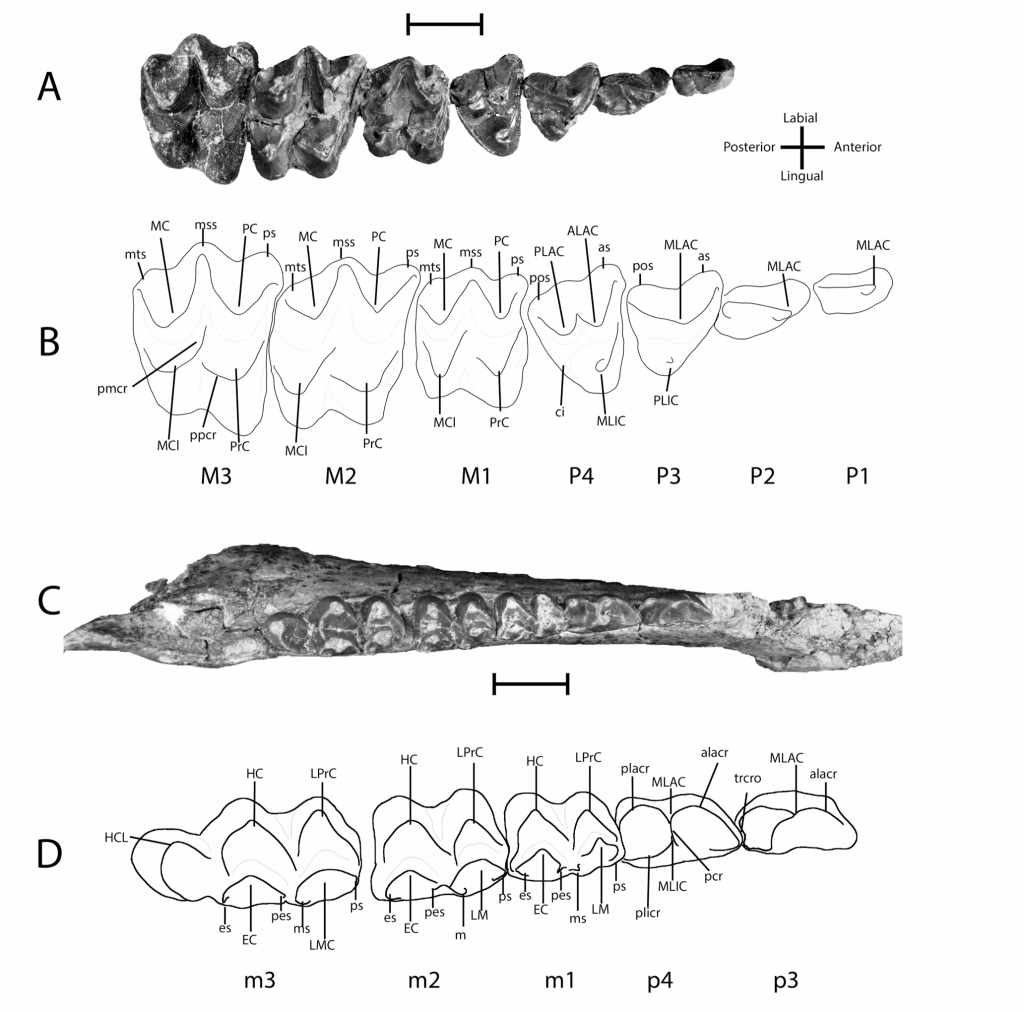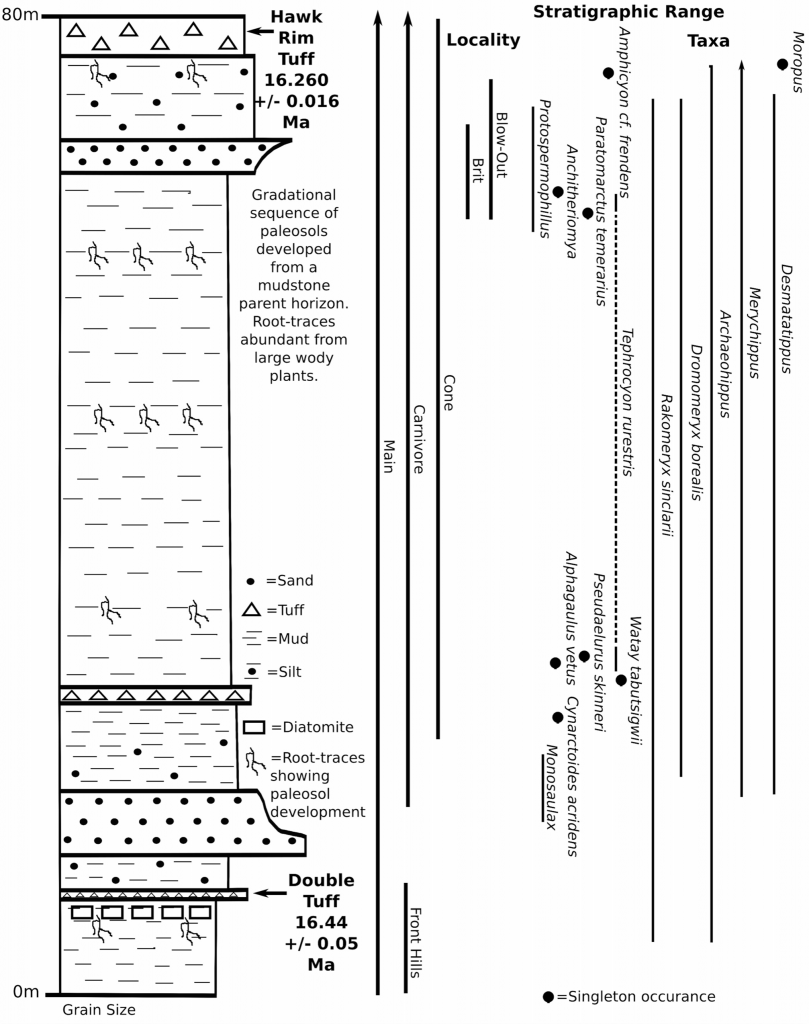Congratulations to Dr. Davis and lab alumna Brianna McHorse who’s paper on identifying the horses from Paisley Cave came out earlier this week. The paper was covered by the University of Oregon in an Around the O article. You can find the article here.
publication
Paper on new late Hemingfordain site published!
Congratulations to Win McLaughlin and Dr. Hopkins on the release of their paper, “A new late Hemingfordian vertebrate fauna from Hawk Rim, Oregon, with implications for biostratigraphy and geochronology” online early today in the Journal of Vertebrate Paleontology! This is the first publication from Win’s masters thesis work. Check out the paper here.
New paper on enamel complexity and body size in horses!
Congratulations to Nick Famoso and Edward Davis who’s paper, “On the relationship between enamel band complexity and occlusal surface area in Equids (Mammalia, Perissodactyla),” came out today in the journal PeerJ. They used fractals to quantify enamel band complexity on the chewing surface of horse teeth and investigated the relationship between complexity and body size while accounting for phylogeny. They found that as horses get bigger, their teeth become less complex! You may view the paper here.

Figure 4: Phylogeny used in this study with continuous characters, tooth area and fractal dimensionality (D), mapped onto the tree. This tree is a time-scaled (Ma) informal supertree. Characters were mapped using the contMap function in the phytools package version 0.4–45 (Revell, 2012) implemented in R. Length refers to the length of the legend in units of branch length. † = extinct taxon.
Paper published on 50 million years of rhino arthritis
Lab alumna Kelsey Stilson and PI’s Drs. Hopkins and Davis published a paper today discussing the evolution of arthritis in rhinos in the open-access journal PLoS ONE. They found that with increased mass, adaptation to running, and increased life span, there is an increase in arthritis in the limb bones of rhinos. Congratulations on your paper!

Figure 1: Time-calibrated phylogeny of rhinocerotid taxa used in this study with outgroup H. eximius. The thicker bars indicate the actual first and last appearance data (FAD and LAD) of the fossil localities included, not the comprehensive range of the species. D. bicornis has no blue line because only modern bones were examined. Tree was pruned from Cerdeño’s 1998 morphologic phylogeny or Rhinocerotidae and time-calibrated in RStudio using the ‘equal’ setting in the function timePaleoPhy() in the software package ‘Paleotree’. Tree was set to be fully dichotomous and to extend all the way to the LAD.
New Species of Agriochoerid Named!
A new paper online early today in the Journal of Vertebrate Paleontology, written by grad student Meaghan Emery and PI’s Drs. Davis and Hopkins, named a new species of agriochoerid (clawed-oreodont) from the Hancock Mammal Quarry in eastern Oregon! They not only name the new species, but they also discuss variation and all of the reason why this is a new and different species. Check it out here. Congratulations on your good work!

FIGURE 1. Tooth rows from UOMNH specimens, and diagrams of tooth terminology. A, B, image and diagram of upper tooth row, a composite specimen with the M3 of F-28324, the M2 and M1 of F-27687, and the P1–P4 of F-27697; C, D, image and diagram of lower tooth row of UCMP V75203/196318. Abbreviations: alacr, anterolabial cristid; alicr, anterolingual cristid; ALC, anterolabial cone; as, anterior style; ci, cingulum; EC, entoconid; es, entostylid; HC, hypoconuid; HCL, hypoconulid; MC, metacone or metaconid; MCL, metaconule or metaconulid; MLAC, mesolabial cone or conid; MLIC, mesolingual cone or conid; mss, mesostyle or mesostylid; mts, metastyle or metastylid; PC, paracone or paraconid; pcr, protocristid; pes, pre-entostylid; placr, posterolabial cristid; PLIC, posterolingual cone; plicr, posterolingual cristid; pmcr, postmetaconulecrista; pos, posterior style; ppcr, postprotocrista; PrC, protocone or protoconid; prpcr, preprotocristid; ps, parastyle or parastylid; tcr, transverse cristid; trcro, transverse cristid oblique. Image D taken by Dave Strauss and released under a CC-BY 3.0 license. All scale bars equal 1 cm.
New Paper Published!
Grad student Nick Famoso and PI’s Edward Davis and Samantha Hopkins had a paper published online early today! The paper, titled “Are Hypsodonty and Occlusal Enamel Complexity Evolutionarily Correlated in Ungulates?,” was published in the Journal of Mammalian Evolution. You may find a copy of the paper here. Congratulations to them and their two additional co-authors!


You must be logged in to post a comment.